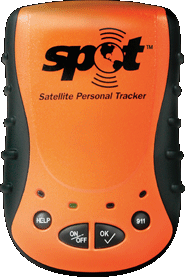Initial Thoughts
I got the SPOT Satellite Messenger primarily for trips like my Idaho backcountry trip last year. You are down low in the mountains for multiple days of flying with no access to FSS or ATC. If something goes wrong, you want some way of sending out an emergency signal. The other thing I like it for is flying around the Rocky Mountains here. I put the device on top of the dash, and click the "I'm OK" at the beginning of the flight, put it into tracking mode during the flight, and click "I'm OK" at the end. This makes the web tracking work best. If something happened on the flight, I would immediately hit the "911" button before even emergency landing.

Look around for deals for the service, I was able to get mine free if I signed up for a 1-year subscription including tracking. I have at least heard of discounts since then, but not free. The tracking is an extra fee, but it seems worth it.
There are lots of reviews out there on the SPOT satellite messenger. Here is a good SPOT review on equipped.com and another SPOT review on gpsmagazine.com.
Use on Long Trips
Then I thought of an even better way to use this during long trips. There is a "Remarks" section in the flight plan form. I figure there ought to be a way to let FSS know I have one of these things.
Before my flight, on the Spot Web Site, I logged into my account, click the "Share" tab. Here, you can either create a new shared page for showing your tracking path or find a previously created page. Once you are viewing the page, capture the long, convoluted link and make a smaller link using tinyurl.com. You can make up whatever smaller url link you want or tinyurl.com can make a random one for you.
The next part is to put this newly created tinyurl.com link into your "remarks" section of the FSS Flight plan. I think the duat.com did not like the ":" in "http://", but was fine with the rest of the link. I also talked with FSS on the phone on one of my legs and told him about adding it to my remarks section. He was intrigued by the concept and said he would watch my flight on the web as it progressed. That is very cool to hear; somebody in FSS watching your flight from the ground.
Then I track the flight with the SPOT like I mentioned above. Note: you have to do the "I'm OK" at the beginning and end or the web tracking does not work right.
My Last Trip Tracking
It is also fun to see the track of your trip. Below is a picture of my track from my Spot Tracking page. This one has all the labels:
You can turn off the labels to make it more readable:
There is an altitude profile as well that you can show, but I am not sure how accurate that is:
Other Emergency Beacons
The SPOT satellite messenger goes through the SPOT system and not the government ELT methods, so I do wonder about getting a Personal Locator Beacon (PLB) sometime in addition. This works similar to the ELT in your plane and works with 121.5Mhz and 406Mhz and provides GPS coordinates to accurately find you. No subscription plan is needed for these devices and it works world-wide. The one I am currently looking at for the future is the McMurdo Fast Find PLB Model 210. But there is no tracking capability and no "I'm OK" button. It only works as an emergency device.
Summary
I think everybody should have some sort of SPOT or Personal Locator Beacon (PLB). For the plane and for the outdoors. I have a friend who got stuck in a blizzard overnight and really wishes he had one of these things. I really like the idea that it can show your track even before you have a problem. What happens if your ELT does not activate when you go down, with this device search and rescue could get a lot closer to where you are. Within about 10 minutes of flying time since it tracks every 10 minutes. If you file a flight plan, they just know your approximate route and no idea where you went down. One way to help this is to file PIREPs or do Flight Following, but this is not always practical.
/Brian


5 comments:
Brian,
I am a huge fan of the SPOT. I think this tool will very quickly revolutionize the rescue community. It has unique strengths and weaknesses, but understanding its capabilities is key.
Thanks for sharing
John
There was a good article just put in the Feb 2010 issue of AOPA Pilot Magazine describing how SPOT was used in a plane rescue in backcountry Idaho. It is a good read.
We've been using spot while flying with inconsistent results...can't always tell if it went into tracking mode, and sometimes it starts out fine and then 'loses' the ability to track during flight, so the tracking map just dead-ends where it quit even though the unit is still on. We've never been able to tell if this is just an intermittently bad unit or if the whole system is that buggy
My spot has been pretty reliable as long as it has a good view of the sky. If it misses a tracking point, it usually gets the next one. I am not sure I have noticed it missing any during flying, but have sometimes on the ground in the woods in a canyon.
There are LEDs to indicate if you are in tracking mode. The newer version of the SPOT is a little easier to understand since there is specific Tracking button and LED. On the older unit it is shared with the OK button.
/Brian
Appreciate yyour blog post
Post a Comment